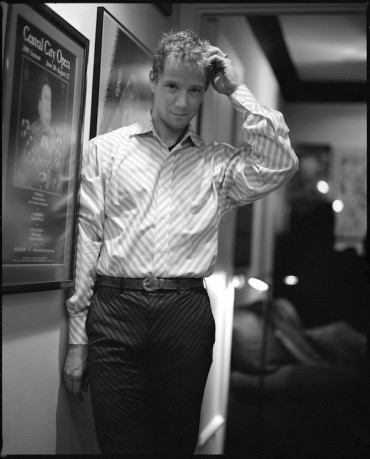The Well-Tempered Ear
Classical music: “It always starts from the singing line.” Composer and librettist Mark Adamo talks about creating his popular opera “Little Women,” which will be performed twice this weekend by the Madison Opera.
1 Comment
By Jacob Stockinger
The Madison Opera will present its modernist production of the popular contemporary opera “Little Women” (below, in a traditional production by the Calgary Opera) by Mark Adamo this weekend.

Christina Ryan,Calgary Herald CALGARY, AB.:JANUARY 21, 2010 — Calgary Opera’s Canadian premiere production ‘Little Women’ stars Krisztina Szabo as Meg, Allyson McHardy as Joe, Mariateresa Magisaro as Beth, and Catherine May as Amy in Calgary on January 21, 2010.(Photo by Christina Ryan/Calgary Herald)
Performances are in the Capitol Theater of the Overture Center on Friday at 8 p.m. and on Sunday at 2:30 p.m.
Tickets to the opera, based on Louisa May Alcott’s famous 19th-century American novel of the same name, run $21-$101. You can call the Overture Center box office at 608 258-4141.
The production features guest conductor Kyle Knox (below), a busy and experienced musician who is a graduate student at the University of Wisconsin-Madison School of Music. His dramatic story was featured on this blog yesterday:
Candace Evans (below) returns as the stage director:
Heather Johnson (below) returns to sing the lead role of Jo March:
“Little Women” will be sung in English with projected surtitles.
The running time is 2-1/2 hours with one intermission.
Also, Mark Adamo is doing the pre-show talk on Friday night in tandem with the Madison Opera’s general director Kathryn Smith. Says Smith: “That means I’m going to ask him questions, so he can talk about his opera instead of me doing so as usual. That is at 7 p.m. in the Wisconsin Studio of the Overture Center, and is free to ticket holders.”
For more information about the opera, tickets, the cast and the production as well as the pre-performance lecture and post-performance Q&A, visit:
http://www.madisonopera.org/performances-2015-2016/little_women/
Here is a link to Mark Adamo’s informative website, where you can also see what other music Adamo, who teaches composition at New York University, composes:
And here is link to his entry on Wikipedia:
https://en.wikipedia.org/wiki/Mark_Adamo
Adamo – who will attend the Friday night performance — generously agreed to a recent email interview with The Ear:
Is there anything beyond what is on your website that you think readers should know about you, your background and your career, including your latest and upcoming projects?
The website has only a little detail about “Becoming Santa Claus,” which is my fourth opera and which was given a lovely premiere (below) in Dallas in December. I’m editing the soundtrack for an upcoming DVD of the piece even as we speak.
What attracted you to “Little Women” as a subject for an opera?
I actually resisted it up front. I thought it was charming, but too antique and undramatic even to speak, let alone sing.
I was drawn to it only when I realized the show was neither “Three Weddings and a Funeral” (that is, not a story of all the March girls, save Beth, growing up to marry) nor a story of a girl struggling to be an artist (her whole family supports her) but a startling, and startlingly proto-modern, story of a girl/woman who learns too late that the destinies of even those she loves are out of her control.
Once it occurred to me that it was the story of everyone who’s ever heard, or uttered, the words, “I love you, but I have to leave” — and didn’t know why it had to be so — I knew the piece could sing.
How difficult a challenge is it for you to do both the score and the libretto? Do you prefer doing one to the other or find one easier?
For me, it’s natural. I was trained not only as a musician but as a playwright and lyricist (and, less comprehensively, as an actor and director) and, temperamentally, I’m the sort of artist who likes to take the most various, and longest possible, view of the project first before I start it.
An opera is a structure of words and music designed to be acted So the more questions I ask myself up front, the clearer both the script and the score can become even before they’re created, because the piece has been conceived in toto first and then the words and music designed to express it.
So I ask myself: What is the story? How can the journey of this character tell it? What is the sound of this story as verbal diction? Vocal contour? Harmonic mass? Melodic line? (Below are the handwritten manuscript and published score to a work by Mark Adamo.)
How would you describe the style of your music to the general public?
It always starts from the singing line. But I let the emotion of the character and the flow of the story determine everything else.
If the character feels like she’s making beautiful discoveries as she falls in love, the harmonies open up, moving from key to key before it settles when she does. If the conversation is turbulent, unsettled, inconclusive, the music is similarly fugitive.
Technically, that means the music is tonal, except when it’s chromatic; harmonic, unless just a sound or an orchestral color can carry the meaning; rhythmically steady, unless rhythms careen every which way to follow the turns of argument. In sum, it is eclectic — but not arbitrarily so. (NOTE: In a YouTube video at the bottom, you can hear an example in Beth’s aria from the production of “Little Women” by the Fayetteville Opera.)
“Little Women” has been performed in more than 65 international productions. What do you think has made it so popular? What is the usual public reaction to the work?
It’s actually over 100 at this point. Obviously, the path of the opera begins with the novel, one of the most beloved in English since its publication. Obviously, you try, as an artist, to make a piece as true and clear and deep as you can. But you can’t control whether artists subsequently believe in that piece (or not), or whether audiences embrace it (or not.)
Eighteen years after its premiere, my only possible response is gratitude that this opera is still speaking so often and to so many.
Tags: America, American literature, Arts, Becoming Santa Claus, Calgary, Canada, Candace Evans, cast, choral music, chormaticism, Christmas, Classical music, Dallas, DVD, English, harmony, Heather Johnson, Jacob Stockinger, lecture, Little Women, Louisa May Alcott, Madison, Madison Opera, Madison Symphony Orchestra, manuscript, Mark Adamo, Music, New York City, New York University, novel, opera, Orchestra, Overture Center, Q&A, rhythm, Santa, Santa Claus, score, singer, stage director, surtitle, Texas, Three Weddings and a Funeral, tonal, University of Wisconsin-Madison School of Music, University of Wisconsin–Madison, words, YouTube





